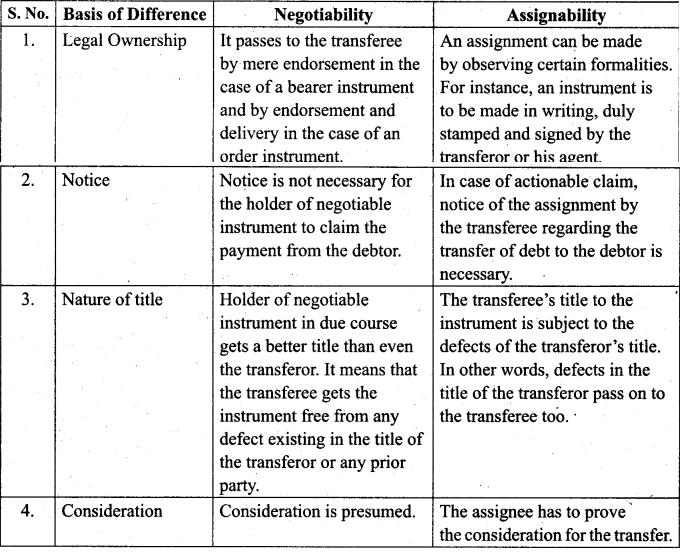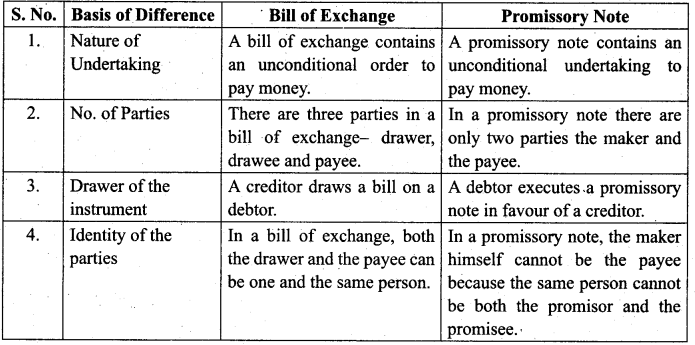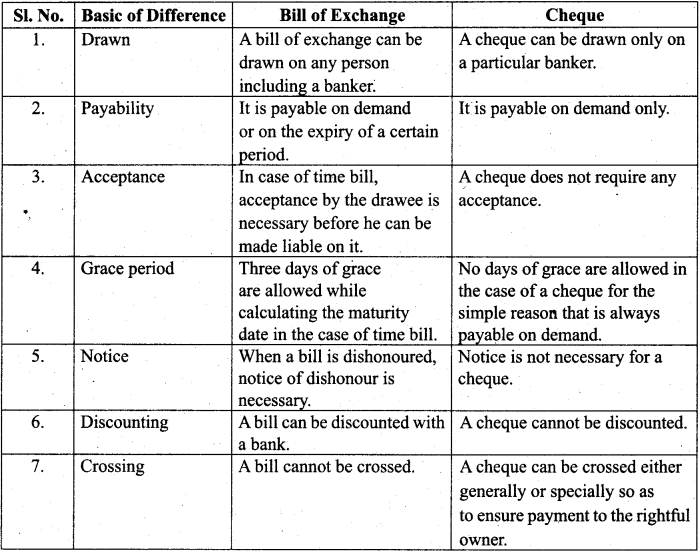TN 12th Commerce Solutions Chapter 22 The Negotiable Instruments Act 1881
Tamilnadu 12th Commerce Solutions Chapter 22 The Negotiable Instruments Act 1881. 12th standard students who want to get full marks in public examinations conducted by the Tamilnadu government must go through this guide. This is a book back answers all in one page. This guide is separated by chapter wise. One mark two mark and all brief questions are answered on this page

TN 12th Commerce Solutions Chapter 22 The Negotiable Instruments Act 1881 Textbook Exercise Questions and Answers
I. Choose the Correct Answer
Question 1.
Negotiable Instrument Act was passed in the year ________
(a) 1981
(b) 1881
(c) 1994
(d) 1818
Answer:
(b) 1881
Question 2.
Negotiable Instrument is freely transferable by delivery if it is a ________ instrument.
(a) Order
(b) Bearer
(c) Both a and b
(d) None of the above
Answer:
(b) Bearer
Question 3.
The transferee of a Negotiable Instrument is the one ________
(a) Who transfer the instrument
(b) On whose name it is transferred
(c) Who enchases it
(d) None of the above
Answer:
(b) On whose name it is transferred
Question 4.
Number of parties in a bill of exchange are ________
(a) 2
(b) 6
(c) 3
(d) 4
Answer:
(c) 3
Question 5.
Section 6 of Negotiable Instruments Act 1881 deals with ________
(a) Promissory Note
(b) Bills of exchange
(c) Cheque
(d) None of the above
Answer:
(c) Cheque
Question 6.
________ cannot be a bearer instrument.
(a) Cheque
(b) Promissory Note
(c) Bills of exchange
(d) None of the above
Answer:
(a) Cheque
Question 7.
When crossing restrict further negotiation ________
(a) Not negotiable crossing
(b) General Crossing
(c) A/c payee crossing
(d) Special crossing
Answer:
(a) Not negotiable crossing
Question 8.
Which endorsement relieves the endorser from incurring liability in the event of dishonour?
(a) Restrictive
(b) Facultative
(c) Sans recourse
(d) Conditional
Answer:
(b) Facultative
Question 9.
A cheque will become stale after ________ months of its date.
(a) 3
(b) 4
(c) 5
(d) 1
Answer:
(a) 3
Question 10.
Document of title to the goods exclude ________
(a) Lorry receipt
(b) Railway receipt
(c) Airway bill
(d) Invoice
Answer:
(d) Invoice
II. Very Short Answer Questions
Question 1.
What is meant by Negotiable Instrument?
Answer:
- The word “Negotiable” means “Transferable” from one person to another in return for consideration.
- It is a document which entitles a person to a certain sum of money and which is transferable from one person to another by mere delivery or by endorsement and delivery.
Question 2.
Define Bill of Exchange.
Answer:
According to section 5 of the Negotiable Instruments Act, “a bill of exchange is an instrument in writing containing an unconditional order, signed by the maker, directing a certain person to pay a certain sum of money only to, or to the order of a certain person or to the bearer of the – instrument”.
Question 3.
List three characteristics of a Promissory Note.
Answer:
- A Promissory Note must be in writing.
- It must contain a promise or undertaking to pay.
- The promise to pay must be unconditional.
- It must be signed by the maker.
Question 4.
What is meant by a cheque?
Answer:
According to section 6 of the Negotiable Instruments Act, 1881 defines a cheque is “a bill of exchange drawn on a specified banker and not expressed to be payable otherwise than on-demand”.
Question 5.
Define Endorsement.
Answer:
“Where the maker or the holder of the negotiable instrument signs the same, otherwise than as such maker/for the purpose of negotiation, on the back or face thereof, or on a slip of paper annexed thereto, he is said to endorse the same, and is called the endorser”. – NEGOTIABLE INSTRUMENT ACT 1881, SEC -15
III. Short Answer Questions
Question 1.
Explain the nature of a Negotiable Instrument.
Answer:
Transferability:
- A negotiable instrument is transferable from one person to another without any formality, such as affixing stamp, registration etc.
- In case it is payable to Bearer – mere delivery.
- In case it is payable in Order – Endorsement delivery.
Title of the holder free from all defects :
When the instrument is held by the holder in due course in the process of negotiation, it cured of ail defects in the instrument with respect to ownership.
Right of the transferee to sue:
Though a Bill or a promissory note or a cheque represents a debt, the transferee is entitled to sue on the instrument in his own name in case of dishonour without giving notice to the debtor that he has become its holder.
Question 2.
Distinguish between Negotiability and Assignability.
Answer:

Question 3.
What are the characteristics of a bill of exchange?
Answer:
- The instrument must be in writing.
- Signed by the maker [Drawer].
- Order must be unconditional.
- The amount payable must be certain.
- The person to whom the bill is drawn must be specified.
- Drawer, Drawee, and Payee must ail be certain.
Question 4.
Distinguish between Bill of Exchange and Promissory Note.
Answer:

III. Short Answer Questions
Question 1.
Explain the meaning of the Agreement to sell.
Answer:
The property (ownership or title) in the goods has to pass at a future time or after the fulfillment of certain conditions specified in the contract.
Question 2.
Discuss in detail existing goods.
Answer:
Existing Goods:
These are the goods [stock – in – Trade] owned by the seller at the time of contract of sale or refer to sale by Agents or by pledger.
Specific Goods:
It denotes the goods identified [selected] and agreed upon at the time of contract of sale.
Ascertained Goods:
It is also used as similar in meaning to specific goods.
Unascertained Goods (or) Generic goods:
These are the goods that are not identified [not selected] and agreed upon at the time of contract of sale.
Question 3.
Discuss the implied conditions and warranties in the sale of goods contract.
Answer:
1. Implied conditions:
a) Conditions as to Title:
In the case of a sale, (buyer can assume) the seller has a right to sell the goods.
b) Conditions as to Description:
In a contract of sale by description, there is an implied condition that goods supplied should agree with the description made by the seller.
c) Sale by Sample:
Where goods are sold by showing samples by the seller [eg. cloth, medicine etc] the bulk of goods supplied by the seller should be similar to the samples shown
2. Implied Warranties:
a) Free from any Encumbrances [Obstruction]
The goods bought must not have any charge or obstruction on right in favour of a third party.
If the buyer’s possession is disturbed by any obstruction, he is entitled to claim damages for breach of warranty.
Warranty in the case of Dangerous goods:
The seller Knows, the goods sold by him are dangerous or likely to be dangerous. But the buyer does not know the dangers.
Question 4.
Discuss in detail the rights of an unpaid seller against the buyer personally.
Answer:
Where the Property in the Goods does not pass to the Buyer. Right of an Unpaid Seller against the Buyer Personally:
- Suit for price
- Suit for Damages for Non-acceptance
- Suit for Cancellation of the Contract before the Due Date- Where the buyer cancels the contract before the date of delivery, the seller may either treat the contract as continuing or wait till the due date.
- Suit for Interest
IV. Long Answer Questions
Question 1.
Mention the presumptions of Negotiable Instruments.
Answer:
Negotiable Instruments presumed to have been.
- Drawn, Accepted, etc. for consideration.
- Reasonable time (Accepted within them) after the date and before its maturity.
- The endorsement made in the order to which they appear thereon.
- Accepted.
- Made before maturity.
- Stamped duly.
Question 2.
Distinguish a cheque and a bill of exchange.
Answer:

Question 3.
Discuss in detail the features of a cheque.
Answer:
Signed by the Drawer:
- A Cheque is to be signed by the drawer.
- Further, it should tally with the specimen signature furnished to the bank at the time of opening the Account.
A certain sum of money only :
- The order must be for payment of money only.
- Further, the sum of money must be certain.
Unconditional order:
- The order must be unconditional.
- A Cheque is an order to pay and is not a request.
- Pay itself denotes a command and words like ‘please’ or ‘kindly’ are dispensed with in a cheque.
Drawn on a Specified Banker Only:
- The cheque is always drawn on a specified Banker.
- The customer of a Bank can draw the cheque only on the particular Bank (Branch) where he has an account.
The instrument in writing:
- A cheque must be an instrument in writing. (Ink)
- Though the Law does not prohibit a cheque from being written in Pencil, Bankers never accept it because of risks involved.
- Alteration is quite easy but detection is impossible in such cases.
Payee to be certain:
- The cheque must be payable to a certain person or to the order of a certain person or to
Payable on-demand: - A cheque is always payable on demand.
Question 4.
What are the requisites for a valid endorsement?
Answer:
Backside:
The endorsement is usually made on the backside of an instrument.
Allonge:
When there is no space for making further endorsements a piece of paper can be attached to the negotiable instrument for this purpose. This piece of paper is called “ALLONGE”.
Delivery:
The endorsement is complete only when delivery of the instrument is made.
Names:
The prefixes (Thiru, Mr., Mrs., Dr., etc….) or suffixes (Avargal, IAS, M.com, etc….) added to the names of the payees or endorsees must be omitted in the endorsement.
The endorsement in Ink:
The endorsement must be in Ink.
Wrongly spelled:
If the endorsee’s name is wrongly spelled [VIRAT – VEER AT] the endorser should sign the same spelled in the instrument and write the correct spelling in brackets.
Signing:
Signing in block letters [sign – RAAJA] does not constitute a regular endorsement.
Duly authorised:
A person who is duly authorised to endorse an instrument must indicate that he is signing in it on behalf of his principal by using such words “for”, or “on behalf of” or “per pro”.
Question 5.
Explain the different kinds of endorsements.
Answer:
When the person signs on the back of the instrument to transfer his interest, it is known as an endorsement. The endorsement are of various types:
(i) Blank or general endorsement:
When the endorser puts his mere signature on the back of an instrument without mentioning the name of the person to whom the endorsement is made, it is called Blank Endorsement
(ii) Endorsement in full or special endorsement:
If the endorser, in addition to his signature, mentions the name of the person to whom it is endorsed, is known as an endorsement in full or special endorsement.
(iii) Conditional endorsement:
When the endorser of a negotiable instrument makes his liability dependent upon the happening of an event which may or may not happen, it is called a conditional endorsement,
(iv) Restrictive endorsement:
When an endorsement restricts or prohibits further negotiability of the instrument, it is called Restrictive Endorsement.
(v) Partial Endorsement:
Where the endorsement seeks to transfer only a part of the amount payable under the instrument, the endorsement is called Partial Endorsement.
TN 12th Commerce Solutions Chapter 21 The Sale Of Goods Act 1930 Additional Questions and Answers
I. Choose the Correct Answer
Question 1.
Section ……………………….. defined the promissory Note.
a) 10
b) 15
c) 4
d) 6
Answer:
c) 4
Question 2.
Grace days allowed to a Bill of exchange for calculation of due date is
(a) 4
(b) 10
(c) 3
(d) 5
Answer:
(c) 3
II. Very Short Answer Questions
Question 1.
What are forms of LPG?
Answer:
Form of Liberalisation (FIL):
Freedom for Expansion: The industries are free to decide their production limits by their own on the basis of the requirement of the markets.
Investment Limit:
The investment limit of the small scale industries has been raised to a crore
Liberalization of Export and Import:
By simplifying the procedures for Imports and Exports the Government wanted to permit the inflow of Goods and Services, capital, HR, and technology.
Question 2.
What are the forms of Globalisation?
Answer:
Forms of Globalization:
- Foreign trade policy
- Export promotion
- Freedom to repatriate
- Reduction in tariffs
- Encouraging open competition
III. Short Answer Questions
Question 1.
What are the Advantages and Disadvantages of Globalisation?
Answer:
Advantage: (TIER)
- Technological Development: Technological advancement paves way for a company to enter a foreign market.
- Increase in foreign: It increases the foreign collaboration such as joint venture collaboration merger -Franchise etc.
- Expansion of market: ‘The operation of business moves from national to international.
- Reduction in Brain Drain: It paves, way for employment opportunities in the home country and utilise the manpower efficiently.
DisAdvantages (DIL)
- The dominance of Foreign Institution: Economic powers shifted from independent industries to foreign institutions which is a threat to national sovereignty.
- Increase inequalities: It widens the gap between rich and poor.
- Loss of domestic industries: It causes a decline in the demand for domestic, products.
TN 12th Commerce Guide Book Back Answers
TN 12th Commerce Book Back Answers

Unit 1 Management Process
- Chapter 1 Principles of Management
- Chapter 2 Functions of Management
- Chapter 3 Management By Objectives (MBO) and Management By Exception (MBE)
Unit 2 Financial Markets – I
Unit 3 Financial Markets – II
Unit 4 Human Resource Management
- Chapter 9 Fundamentals of Human Resource Management
- Chapter 10 Recruitment Methods
- Chapter 11. Employee Selection Process
- Chapter 12 Employee Training Method
Unit 5 Elements of Marketing
- Chapter 13 Concept of Market and Marketer
- Chapter 14 Marketing and Marketing Mix
- Chapter 15 Recent Trends in Marketing
Unit 6 Consumer Protection
Unit 7 Business Environment
Unit 8 The Sale of Goods Act, 1930 and The Negotiable Instruments Act, 1881
Unit 9 Entrepreneurship Development
- Chapter 23 Elements of Entrepreneurship
- Chapter 24 Types of Entrepreneurs
- Chapter 25 Government Schemes for Entrepreneurial Development
1 COMMENTS
Comments are closed.